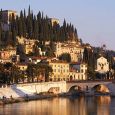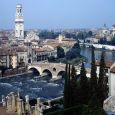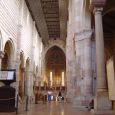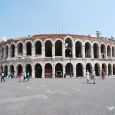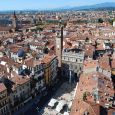Verona
Advertisement
By Air
Verona Airport is located 2.7 NM (5.0 km; 3.1 mi) southwest of Verona.It handles around 3½ million passengers per year. It is linked to Porta Nuova railway station by a frequent bus service.There are direct flights between Verona and Rome Fiumicino, Munich, Naples, Frankfurt, Catania, Paris Charles De Gaulle, London Gatwick, Palermo, Vienna Schwechat, and Cagliari among others.
By Train
Verona lies at a major route crossing where the nouth-south rail line from the Brenner Pass to Rome intersects with the east-west line between Milan and Venice, giving the city rail access to most of Europe. The city is, therefore, served by international, regional and local services.Verona's main station is Verona Porta Nuova railway station, to the south of the city centre. It is considered to be the ninth busiest railway station in Italy, handling approximately 68,000 passengers per day, or 25 million passengers per year.There is a lesser station to the east of the city at Porta Vescovo, which used to be the main station in Verona, but now only receives trains between Venice and Porta Nuova.
By Bus
Buses are operated by the provincial public transport company, Azienda Trasporti Verona (ATV).
Piazza delle Erbe
is a square in Verona, northern Italy. It once was home to the town's Roman forum during the time of the Roman Empire.The northern side of the square is occupied by the ancient town hall, the Torre dei Lamberti, the Casa dei Giudici ("Judges Hall") and the Mazzanti Houses. The western side, the shortest one, features the Baroque Palazzo Maffei, decorated by statues of Greek gods. It is faced by a white marble column, on which is St. Mark's Lion, symbol of the Republic of Venice.The north-western side occupies the site of the ancient Roman Capitol Hill, which looked towards the Forum. Numerous of its buildings facing the square have maintained façade frescoes. On the southern side is the Casa dei Mercanti ("House of the Merchants", also known as Domus Mercatorum), now the seat of the Banca Popolare di Verona. Other buildings are reminiscent of medieval tower-houses.
Colosseum
is an elliptical amphitheatre in the centre of the city of Rome, Italy, the largest ever built in the Roman Empire. It is considered one of the greatest works of Roman architecture and Roman engineering.Capable of seating 50,000 spectators, the Colosseum was used for gladiatorial contests and public spectacles such as mock sea battles, animal hunts, executions, re-enactments of famous battles, and dramas based on Classical mythology. The building ceased to be used for entertainment in the early medieval era. It was later reused for such purposes as housing, workshops, quarters for a religious order, a fortress, a quarry, and a Christian shrine.
Roman theatre of Verona
is an ancient Roman theatre in Verona, northern Italy.The theatre, considered the most important Roman theatre in northern Italy, was built in the late 1st century BC. Before its construction, two walls were built alongside the Adige River, between the Ponte di Pietra and the Ponte Postumio, to protect it against floods.Today only remains of the edifice are visible, recovered starting from around 1830. They include the cavea and the steps, several arcades of the loggias and remains of the stage.
Ponte Pietra
once known as the Pons Marmoreus, is a Roman arch bridge crossing the Adige River in Verona, Italy. The bridge was completed in 100 BC, and the Via Postumia from Genua to the Brenner Pass passed over it.It originally flanked another Roman bridge, the Pons Postumius; both structures provided the city (on the right bank) with access to the Roman theatre on the east bank. The arch nearest to the right bank of the Adige was rebuilt in 1298 by Alberto I della Scala. Four arches of the bridge were blown up by retreating German troops in World War II, but rebuilt in 1957 with original materials.
May - September
December - April


